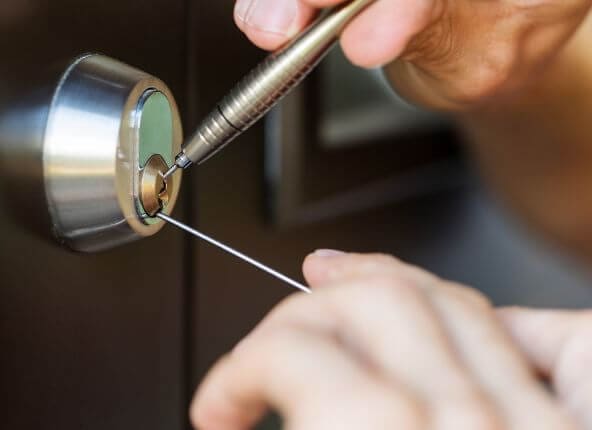
How Easy Is It To Bypass a Europrofile Lock Cylinder?
What is a Europrofile Lock Cylinder? Most people have at least one Europrofile lock cylinder...
Back in the 1990s, when double denim was acceptable, the motor insurers were not happy people. They were having to pay out too much in vehicle theft claims. After all, stealing a car was easy – break the window, unlock the door, break the steering lock, hotwire the ignition, and off they went.
They went to the motor manufacturers and demanded they Do Something About It Or They Would Massively Increase Premiums. So the manufacturers put their thinking caps on, and came up with the concept of the immobiliser, a device that would prevent the engine from starting unless the driver was in the car.
Early iterations of the immobiliser had a keypad in the car – I had a Peugeot with a keypad under the armrest. I can still remember the PIN, 0666, which I thought was actually the STD code of The Beast. Well, it helped me remember it.
Then came the transponder immobiliser. A microchip placed in the key itself would send a code to the engine computer when the ignition was turned on, and that would disengage the immobiliser. In other words, the engine would only start if the key was in the ignition.
And essentially, that’s still the system we use today. There have been some developments, of course, the encrypted transmission of the code, and the use of rolling codes being the two primary developments, but at its heart, it’s a chip with a code in the key that allows the engine to start.
And it worked. You can no longer steal a car by hotwiring.
Great. Let’s all get on with our lives.
Only, no, obviously not. Car thieves still want to thieve cars. They don’t want to give up and go and do something else instead. So, if a car won’t start if the key isn’t there, then they’ll just have to steal the car keys too.
And so the 2-in-1 burglary was born.
If a thief wants to steal your car, you get the traumatic double-whammy of having your house broken into, and your car is stolen.
Generally, this is an organised activity, not an opportunist one. They will be prepared with a set of false registration plates for the make, model, and colour of the vehicle they have targeted – they don’t want to get stopped by a police car equipped with ANPR. Statistically, the most likely cars to be stolen are the high-end German manufacturers, BMW, Mercedes, and Audi, along with Jaguar and Land Rover vehicles. They are valuable enough to be worthwhile stealing, yet popular enough that there are plenty of targets
One member of the gang breaks into your home takes the car keys, and drives the car away, to an agreed location where it is left for 3 or 4 days – that gives the police enough time to locate the vehicle if it has a tracker fitted, and recover it. After that, another member of the gang retrieves the car, and it is then either given a new identity and sold, or broken down for spares.
I have posted before that according to the ONS, 58% of burglaries occur when residents are at home. One of the reasons behind this is that if a resident is not at home, it’s likely that neither the car keys nor the car is at home either. And recent Home Office figures show that car theft has increased by 50% over the last 5 years.
So, what steps can you take to avoid becoming a 2-in-1 burglary victim?
The main strategy is to stop the burglars from breaking in by securing your doors as far as possible. If you have a wooden door, make sure that at least one lock conforms to the latest British Standard for burglary resistance, BS3621:2007. To check, have a look at the plate on the edge of the door, if there is no kitemark, upgrade that lock as soon as you can. If there is a kitemark, check the date on it – any earlier than 2007, then you still need to upgrade.
If you have uPVC or Composite double glazed doors, check that your cylinders have TS007 3* accreditation. To check for this, look at the face of the lock cylinder, underneath the keyhole. If it has 3 stars, maybe with a kitemark or a diamond, you have a 3* lock. If it doesn’t have 3 stars, it needs upgrading. Even if it has 1 star and a kitemark, it still needs upgrading.
Taking simple, inexpensive steps to increase your security levels dramatically decreases vulnerability, your chances of being burgled, even when your home is being targeted for your car. The thing is, the thieves don’t have much time. The more time they take, the more likely they are to be detected and caught. Proper security locks will force them to rethink, to target another home with the type of car they want.
We are, of course, very happy to give free advice, and we’ll come out to your home for free and let you know whether your locks need upgrading. Call us before it’s too late.

What is a Europrofile Lock Cylinder? Most people have at least one Europrofile lock cylinder...

Losing a car key or dealing with a broken one can be a frustrating experience...

If you’ve ever asked yourself that question, then this is the article for you. Consider...
Lorem ipsum dolor sit amet, consectetur adipiscing elit.
For further information about Amberley Security, please do not hesitate to get in touch. We are always happy to help.